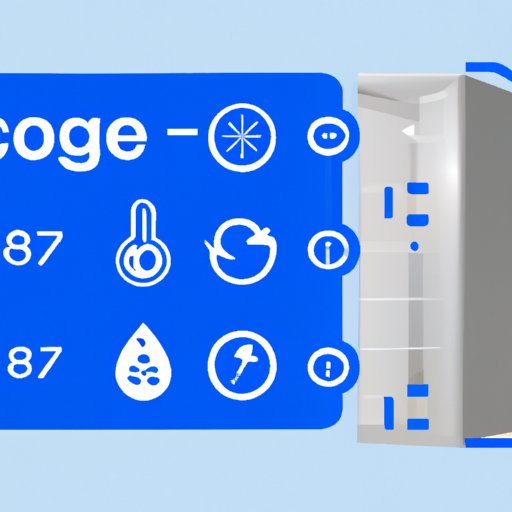Introduction
Having a properly functioning refrigerator is essential for keeping your food fresh and safe from bacteria. But what temperature should your refrigerator be set at? This article will explore the ideal temperature for refrigerators, how to set it, and the science behind getting the perfect temperature.

Exploring the Ideal Temperature for Refrigerators
Why Setting the Right Temperature is Important: The temperature of your refrigerator affects the way food is stored, as well as its shelf life. Too hot, and your food can spoil or become contaminated with bacteria, while too cold can cause freezer burn and other problems. It’s important to find the right balance between the two and keep your fridge at the optimal temperature.
The Recommended Temperature for Your Fridge: The recommended temperature range for most home refrigerators is between 35-38 degrees Fahrenheit (2-3 degrees Celsius). This range is considered optimal because it prevents food from spoiling too quickly and keeps it safe from bacterial growth. It also helps ensure your food stays fresh and tasty.
Setting the Perfect Temperature in Your Refrigerator
Adjusting the Temperature Settings: Most modern refrigerators have a temperature control dial that can be used to adjust the internal temperature. To get an accurate reading, you should place a thermometer inside the fridge and adjust the dial until the desired temperature is reached.
Tips for Getting the Best Results: Here are some tips to help you get the best results when setting the temperature in your fridge:
- Clean the condenser coils regularly to make sure they are working efficiently.
- Check the door seals regularly to make sure they are airtight.
- Set the temperature slightly below the recommended range to account for fluctuations.
- Keep the fridge away from heat sources such as radiators, ovens, and stoves.
How Cold Should Your Fridge Be?
Factors that Affect the Temperature Inside Your Fridge: There are several factors that can affect the temperature inside your refrigerator. These include the size of the fridge, the number of items inside, the ambient temperature of the room, and the placement of the fridge relative to other heat sources.
Understanding the Optimal Temperature Settings: The optimal temperature for your fridge will depend on these factors. Generally speaking, the colder the better, but you should aim to keep your fridge somewhere between 35-38 degrees Fahrenheit (2-3 degrees Celsius). This will ensure your food stays fresh and safe from bacterial contamination.

The Science Behind Setting Your Refrigerator Temperature
The Physics of Setting the Right Temperature: The physics behind setting the right temperature in your refrigerator is quite simple. Cold air is denser than warm air, so when the temperature in the fridge is set too low, the cold air will sink to the bottom, displacing the warmer air. This causes the temperature in the upper part of the fridge to be higher than the lower portion.
The Role of Cool and Warm Air in Your Fridge: To counteract this effect, the fridge needs to be set at the right temperature so that both the cool air and the warm air are balanced. This will ensure that the temperature throughout the fridge is uniform and consistent.
Keeping Food Safe: What Temperature Should Your Fridge Be?
Adhering to Food Safety Standards: Keeping your refrigerator at the right temperature is essential for food safety. If the temperature is too high, bacteria can grow quickly and cause food poisoning. On the other hand, if the temperature is too low, food can freeze and become inedible.
How to Know When You Have the Right Temperature: The best way to tell if you have the right temperature is to use a thermometer. Place the thermometer inside your fridge and check the temperature. If it’s within the recommended range (35-38 degrees Fahrenheit/2-3 degrees Celsius), then you’re all set.

Mastering the Art of Refrigerator Temperature Control
Maintaining a Constant Temperature: To ensure your food stays fresh and safe, it’s important to maintain a constant temperature in your refrigerator. This means keeping the temperature at the same level and not allowing it to fluctuate too much. This can be done by adjusting the temperature control dial and monitoring the thermometer.
Troubleshooting Common Issues with Temperature Regulation: If you find that the temperature in your fridge is still not stable, there could be a few issues to consider. Check the door seals to make sure they are airtight, clean the condenser coils, and make sure the fridge is not too close to any heat sources.
Conclusion
In conclusion, setting the right temperature in your refrigerator is essential for keeping your food safe and fresh. A good rule of thumb is to keep the temperature between 35-38 degrees Fahrenheit (2-3 degrees Celsius). This range is considered optimal because it prevents food from spoiling too quickly and keeps it safe from bacterial growth. To get the best results, make sure to regularly check the temperature with a thermometer and adjust the temperature control dial accordingly. Finally, make sure to keep your fridge away from any heat sources, clean the condenser coils, and check the door seals regularly.
With the right temperature settings and regular maintenance, you can ensure that your food stays safe and fresh. Mastering the art of refrigerator temperature control is an important part of keeping your food safe and healthy.


